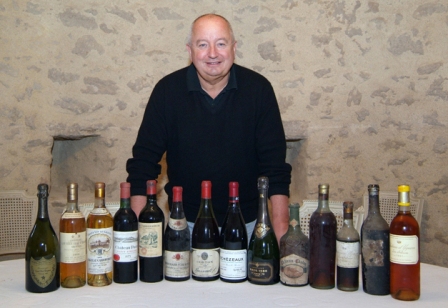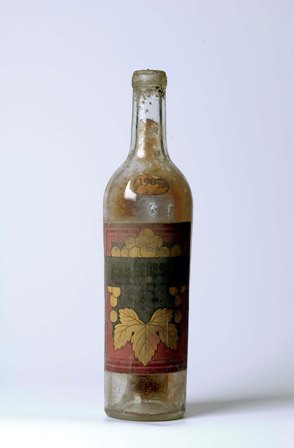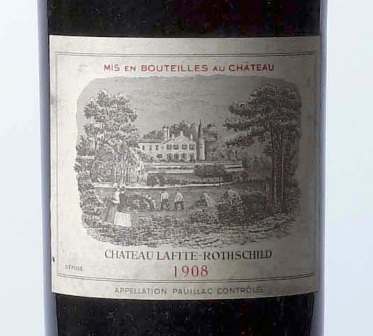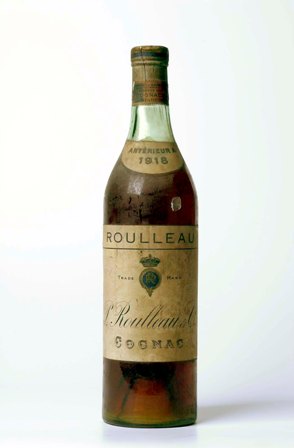I write these lines in two parts. Now, it is just before the dinner.
I have just opened the bottles for a dinner decided at 5 pm.
My son says : “we come”.
As I am trying to put some order in my cellar, I have noticed bottles which have to be drunk.
The Mission Haut-Brion 1929 is certainly dead : big loss of volume, and a cork fallen in the bottle.
I open it without hope, but immediately I smell a particular smell indicating that the wine could live again. Not sure of course, but the possibility exists.
I decanted the wine as the cork was swimming, and the smell was really positive. Not any trace of cork smell. I have no illusion on this wine, but we will see.
The Yquem 1950 is low shoulder. It has to be drunk. When looking at the bottle, what is curious is that the upper part of the wine looks dark and thick, but the lower part is a pure gold. This is certainly due to the glass.
I opened the wine, and a fantastic smell appeared, deep, with a huge botrytis. We will see. I have hope with this one.
To be sure to drink something with no problem, I opened a Lagrange Saint Julien 1975. Nice smell. No problem. Just one curious thing : I have bought this bottle with 23 others in a sale. When, why, I do not know. But they have an additional label of an importer from Buenos Ayres. If it is said that travels forms the youth, I hope it is true also for this wine.
Of course the wounded bottles are only for familial consumption. But when as last year, I opened a Yquem 1921 which had to be drunk and which was perfect, it is worth making tries in our familial circle.
I write now after the dinner.
The Mission 1929 being served had a nice smell. The first sip was agreeable. But it was obvious that the wine is dead. One hour later the smell was still very agreeable, but the wine was hopeless.
The Lagrange 1975 is a very pleasant wine. It has nothing particular to say “wow”, but it is pleasant. The length is not enormous, but the balance, a very fruity appearance, show that we drink a nice wine. Let us say to make an example a wine which would be noted 88. But I would be probably more severe than many notes which are given in this forum.
Then the Yquem 1950. My wife who never drinks except Yquem is enthusiast about the smell and the colour. I am enthusiast for the smell but less for the colour. My son is enthusiast for the wine.
What is my personal view? I would say that this Yquem is in the family of Yquem 1921. An enormous botrytis, some aspects of an essencia, a generous weigth in the mouth. Very great Yquem, but as I am not too much a fan of the very brown Yquem, I am not on a cloud. Obviously a deep Yquem that you could put in comparison with a 1921. But not exactly what I expect from Yquem. I prefer the 28, the 47 or the 55.
Meanwhile, as we were a little short with red wine (so before the Yquem), I opened at the last moment a La Conseillante 1981. Very proper, very well built, but this wine does not talk to me. I had yesterday a wine that I bought the same day (so it had no time to get a seat in my cellar), a Latour à Pomerol 1997. I preferred the Latour to the Conseillante, very acceptable, but with no sign of what makes life happy : something unconventional.
Nice familial dinner. I would be happy to solve the problem of low levels to offer to my children 100% perfect wines. But it gave us an opportunity to open a Yquem 1950 of a high class. Why not ?



 On peut assez aisément imaginer ma fierté de faire le prochain dîner de wine-dinners en ce lieu merveilleux. C’est dû évidemment à l’extrême générosité de Pierre Lurton mais aussi à mon "passeport", un Yquem 1861 dont le château n’a aucune bouteille.
On peut assez aisément imaginer ma fierté de faire le prochain dîner de wine-dinners en ce lieu merveilleux. C’est dû évidemment à l’extrême générosité de Pierre Lurton mais aussi à mon "passeport", un Yquem 1861 dont le château n’a aucune bouteille.